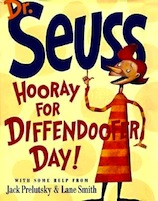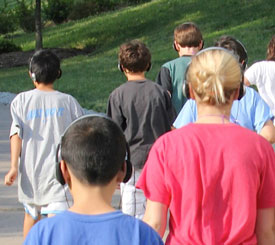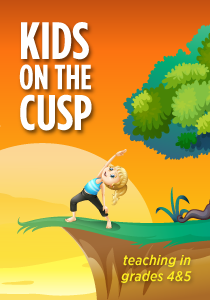My Virtual Classroom Tour
A MiddleWeb Blog
virtual: (1) existing or resulting in essence or effect, though not in actual fact or form; (2) existing in the mind, especially as a product of the imagination.
I began my transition back to school in mid-August. I have a process. It takes a few weeks. Some time in mid-August I find out that my classroom has been cleaned. It’s ready for me. But am I ready for it?
When it comes to summer fun and a day at the pool, I’m one of those jump-right-in people. I admit that this is easier on days when the water isn’t frigid, but, regardless of the temperature, I can’t gradually ease myself into the water. It’s all or nothing. School, on the other hand, is a toe-dipper, starting in mid-August.
The first order of business is to remove the gray garbage bags that have been protecting my bulletin boards. I need the drab to be eradicated. That’s when I start to begin forming my virtual classroom for the upcoming year.
I feel the mood change as the plastic bags come down, and the dreary Flobbertown that was my summer classroom is replaced by bursts of bright orange, purple, red and royal blue. It is only then that I can begin to see the possibilities, to channel my inner Dr. Seuss, the inspiration for one of my favorite picture books, Hurray for Diffendoofer Day!

My class and I refer to reads like these as wisdom books. Someone in a workshop years ago introduced the idea. I wish I could remember who it was so I could give them credit! (Here’s my wisdom book graphic organizer.) I find it to be incredibly effective in forming an initial impression of how my new class responds to literature, how well they interpret a story and make connections to the world.
Diffendoofer Day is about thinking outside the box, about being creative learners. And I must admit that I find it hilarious that the antagonist in the story is the standardized test that all of the kids have to take. If they don’t pass, they have to go to school in dreary Flobbertown! (Here’s the teaching guide.)
The closet-pull
Hurray for Diffendoofer Day is one read aloud that I know I will use this year. I will be using it on the first day of school to help set the tone for the year. It is the first stop on my virtual tour. Other than that, I haven’t decided exactly how we’ll start exploring some of our other topics, but there are lots of possibilities, hence the need for the next phase of back-to-school transitioning — the next stop on my virtual tour. It’s what I call the closet-pull.
For this event, I take the contents of the top two shelves in my closet and classify them into groups. This year I have sorted my loot into five categories: Get-to-Know-You Activities, Reading and Writing Workshop Launch, Regions of the United States, Water and Ecology, and the I’m-Not-Sure What-All-This-Is category. This category seems to be in attendance every year.
Once this phase is complete, I stand in the center of the room and rotate, very slowly, pausing at bulletin boards, envisioning, mulling over the layout, the need for traffic flow, and completing the preliminary cycle of my 360 degree panoramic. This ridiculous practice is exactly what I need to start the juices of creativity flowing, to get me visualizing the imaginary web of connections I might be able to make between all of these topics. It’s a beginning.
Incorporation
I’m very fortunate in that I have the resources I need to teach. I have more than the resources. I have choices. I can choose how I will integrate subjects this year. Instead of reading a required class book, as in my earlier years of teaching, I can select from an array of rich literature to enhance our new literacy philosophy and our current Social Studies and Science Curriculums. Because it is my second year learning how to incorporate a new literacy philosophy, I feel a little more confident. I feel a sense of ease since I’ve seen it in action.

John Borja, a dear friend and colleague, made a video at the end of last year. It highlights the kids’ impressions of this program. I’m going to show it to this year’s crew to give them an idea of what The Walking Classroom all about. (I wrote about here at MiddleWeb.)
Our Walk-its (like a Walkman, kind of) will have a safe spot on the bottom shelf of the purple bookcase. They will share the space with our first Reading Workshop library, donated books, books I’ve collected over the years, and books that have been gifted to me by the kids. Our first genre of study is fiction. It’s nice and broad. I have lots of fiction books. The wall of colorful titles looks inviting on my virtual tour.
The water’s fine
Science materials always put the brakes on my musings when I am on my imaginary sight-seeing expedition. Thankfully, I have decent storage, so the sponges and toothpicks have a home outside of view, but the room needs a Science vibe, too.
Last year we held our first school-wide S.T.E.M. night. Each grade level completed a project-based study, incorporating each letter in the acronym. We built waterwheels as part of ours. We had fun tinkering. Using data we collected during a portion of the project, we had time to explore and analyze statistical landmarks, so I didn’t have to teach a formal lesson on range, median, or mode during “math.”

Even though the paper isn’t up yet (it is currently still perfectly cylindrical in its plastic wrap covering, on a table in the corner), it has inspired me for the last stop on today’s tour, the last step in today’s toe-dipping exercise.
The virtual tour ends with the welcome board in the hallway. It will be my new class’s first stop this coming year. It urges, “Come on in…the Water’s Fine.”
I’ll come back to my room next week, for phase two of Operation September. I’ll come back and put that welcome board up first…


































